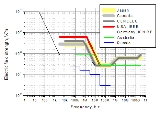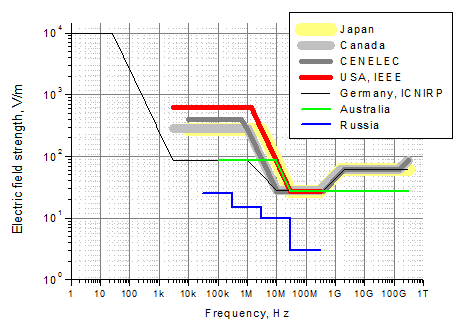
Magnetobiology
Encyclopedia
Magnetobiology is the study of biological effects of mainly weak static and low-frequency magnetic fields, which do not cause heating of tissues. Magnetobiological effects have unique features that obviously distinguish them from thermal effects; often they are observed for alternating magnetic fields just in separate frequency and amplitude intervals. Also, they are dependent of simultaneously present static magnetic or electric fields and their polarization.
Magnetobiology is a subset of bioelectromagnetics
. Bioelectromagnetism
and biomagnetism
are the study of the production of electromagnetic and magnetic fields by biological organisms. The sensing of magnetic fields by organisms is known as magnetoreception
.
Biological effects of weak low frequency magnetic fields, less than about 0.1 mT (1 G
) and 100 Hz correspondingly, constitutes a physics problem. The effects look paradoxical, for the energy quantum of these electromagnetic fields is by many orders of value less than the energy scale of an elementary chemical act. On the other hand, the field intensity is not enough to cause any appreciable heating of biological tissues or irritate nerves by the induced electric currents.
A bright example of magnetobiological effects is the magnetic navigation by migrant animals. It is established that some animals are able to detect small variations of the geomagnetic field
on the order of tens of nanoteslas to find their seasonal habitats.
 Practical significance of magnetobiology is conditioned by the growing level of the background electromagnetic exposure of people. Some electromagnetic fields at chronic exposures may pose a threat to human health. World Health Organization
Practical significance of magnetobiology is conditioned by the growing level of the background electromagnetic exposure of people. Some electromagnetic fields at chronic exposures may pose a threat to human health. World Health Organization
considers enhanced level of electromagnetic exposure at working places as a stress factor. Present electromagnetic safety standards, worked out by many national and international institutions, differ by tens and hundreds of times for certain EMF ranges; this situation reflects the lack of research in the area of magnetobiology and electromagnetobiology. Today, the most of the standards take into account biological effects just from heating by electromagnetic fields, and peripheral nerve stimulation from induced currents.
attempt to treat pain or other medical conditions by relatively weak electromagnetic fields. These methods have not yet received clinical evidence in accordance with accepted standards of evidence-based medicine. Some institutions recognize the practice as a pseudoscientific
one.
Explanation of the physical nature of biological effects of weak magnetic fields is a fundamental scientific problem.
Magnetobiology is a subset of bioelectromagnetics
Bioelectromagnetics
Bioelectromagnetics is the study of the interaction between electromagnetic fields and biological entities. Common areas of investigation include animal navigation utilising the geomagnetic field, potential effects of man-made sources of electromagnetic fields like mobile phones and developing...
. Bioelectromagnetism
Bioelectromagnetism
Bioelectromagnetism refers to the electrical, magnetic or electromagnetic fields produced by living cells, tissues or organisms. Examples include the cell membrane potential and the electric currents that flow in nerves and muscles, as a result of action potentials...
and biomagnetism
Biomagnetism
Biomagnetism is the phenomenon of magnetic fields produced by living organisms; it is a subset of bioelectromagnetism. The study of the biological effects of magnetic fields is magnetobiology...
are the study of the production of electromagnetic and magnetic fields by biological organisms. The sensing of magnetic fields by organisms is known as magnetoreception
Magnetoception
Magnetoception is the ability to detect a magnetic field to perceive direction, altitude or location. This sense plays a role in the navigational abilities of several animal species and has been postulated as a method for animals to develop regional maps.Magnetoception is most commonly observed in...
.
Biological effects of weak low frequency magnetic fields, less than about 0.1 mT (1 G
Gauss (unit)
The gauss, abbreviated as G, is the cgs unit of measurement of a magnetic field B , named after the German mathematician and physicist Carl Friedrich Gauss. One gauss is defined as one maxwell per square centimeter; it equals 1 tesla...
) and 100 Hz correspondingly, constitutes a physics problem. The effects look paradoxical, for the energy quantum of these electromagnetic fields is by many orders of value less than the energy scale of an elementary chemical act. On the other hand, the field intensity is not enough to cause any appreciable heating of biological tissues or irritate nerves by the induced electric currents.
A bright example of magnetobiological effects is the magnetic navigation by migrant animals. It is established that some animals are able to detect small variations of the geomagnetic field
Earth's magnetic field
Earth's magnetic field is the magnetic field that extends from the Earth's inner core to where it meets the solar wind, a stream of energetic particles emanating from the Sun...
on the order of tens of nanoteslas to find their seasonal habitats.
Reproducibility
The results of magnetobiological experiments are poorly reproducible. 10–20% of publications report failed attempts to observe magnetobiological effects. In the majority of experiments, success depended on a rare happy coincidence of suitable electromagnetic and physiological conditions. Many of the experiments await confirmation by independent studies.Safety standards

World Health Organization
The World Health Organization is a specialized agency of the United Nations that acts as a coordinating authority on international public health. Established on 7 April 1948, with headquarters in Geneva, Switzerland, the agency inherited the mandate and resources of its predecessor, the Health...
considers enhanced level of electromagnetic exposure at working places as a stress factor. Present electromagnetic safety standards, worked out by many national and international institutions, differ by tens and hundreds of times for certain EMF ranges; this situation reflects the lack of research in the area of magnetobiology and electromagnetobiology. Today, the most of the standards take into account biological effects just from heating by electromagnetic fields, and peripheral nerve stimulation from induced currents.
Medical approach
Practitioners of magnet therapyMagnet therapy
Magnet therapy, magnetic therapy, or magnotherapy is an alternative medicine practice involving the use of static magnetic fields. Practitioners claim that subjecting certain parts of the body to magnetostatic fields produced by permanent magnets has beneficial health effects...
attempt to treat pain or other medical conditions by relatively weak electromagnetic fields. These methods have not yet received clinical evidence in accordance with accepted standards of evidence-based medicine. Some institutions recognize the practice as a pseudoscientific
Pseudoscience
Pseudoscience is a claim, belief, or practice which is presented as scientific, but which does not adhere to a valid scientific method, lacks supporting evidence or plausibility, cannot be reliably tested, or otherwise lacks scientific status...
one.
Possible causes of the effects
In magnetobiology, theory is lagging far behind experiment. The nature of biological effects of weak electromagnetic fields remains unclear as yet, despite numerous experimental data. The following suggested causes of magnetobiological phenomena are frequently discussed:- Crystallization of iron-bearing magnetic nanoparticlesNanoparticleIn nanotechnology, a particle is defined as a small object that behaves as a whole unit in terms of its transport and properties. Particles are further classified according to size : in terms of diameter, coarse particles cover a range between 10,000 and 2,500 nanometers. Fine particles are sized...
in tissues of the organism, - Dependence of some biochemical free-radical reactionsRadical (chemistry)Radicals are atoms, molecules, or ions with unpaired electrons on an open shell configuration. Free radicals may have positive, negative, or zero charge...
on the magnetic field magnitude, - Possible existence of long-lived rotational statesRotational transitionA rotational transition is an abrupt change in angular momentum in quantum physics. Like all other properties of a quantum particle, angular momentum is quantized, meaning it can only equal certain discrete values, which correspond to different rotational energy states. When a particle loses...
of some molecules inside proteinProteinProteins are biochemical compounds consisting of one or more polypeptides typically folded into a globular or fibrous form, facilitating a biological function. A polypeptide is a single linear polymer chain of amino acids bonded together by peptide bonds between the carboxyl and amino groups of...
structures, - Magnetically induced changes in physical/chemical properties of liquid waterWaterWater is a chemical substance with the chemical formula H2O. A water molecule contains one oxygen and two hydrogen atoms connected by covalent bonds. Water is a liquid at ambient conditions, but it often co-exists on Earth with its solid state, ice, and gaseous state . Water also exists in a...
.
Explanation of the physical nature of biological effects of weak magnetic fields is a fundamental scientific problem.
Profile scientific journals
Further reading
- Presman A.S. Electromagnetic Fields and Life, Plenum, New York, 1970.
- Kirschvink J.L., Jones D.S., MacFadden B.J. (Eds.) Magnetite Biomineralization and Magnetoreception in Organisms. A New Biomagnetism, Plenum, New York, 1985.
- Binhi V.N. Magnetobiology: Underlying Physical Problems. — Academic Press, San Diego, 2002. — 473 p. — ISBN 0-12-100071-0
- Binhi V.N., Savin A.V. Effects of weak magnetic fields on biological systems: Physical aspects. Physics – Uspekhi, V.46(3), Pp.259–291, 2003.

